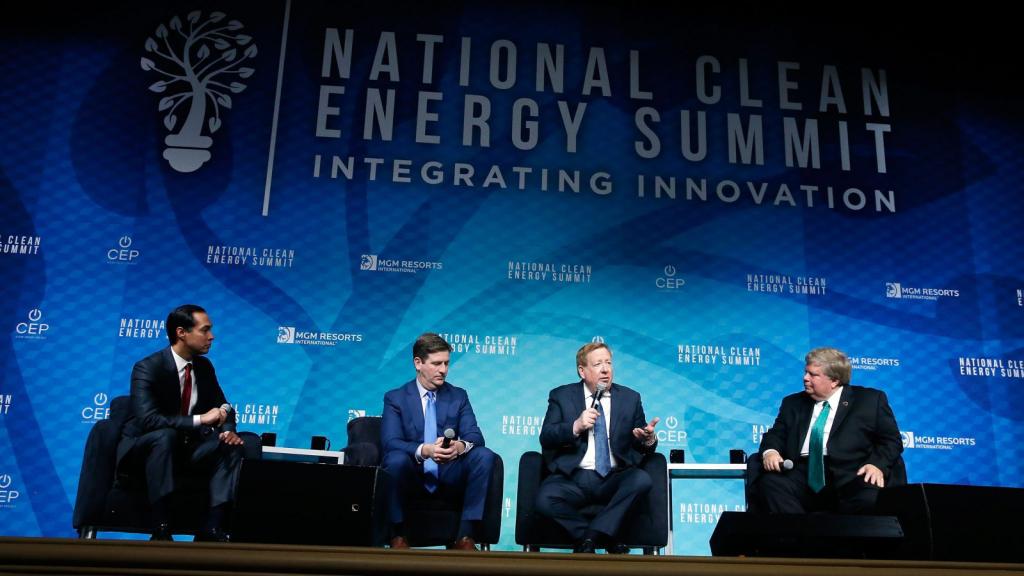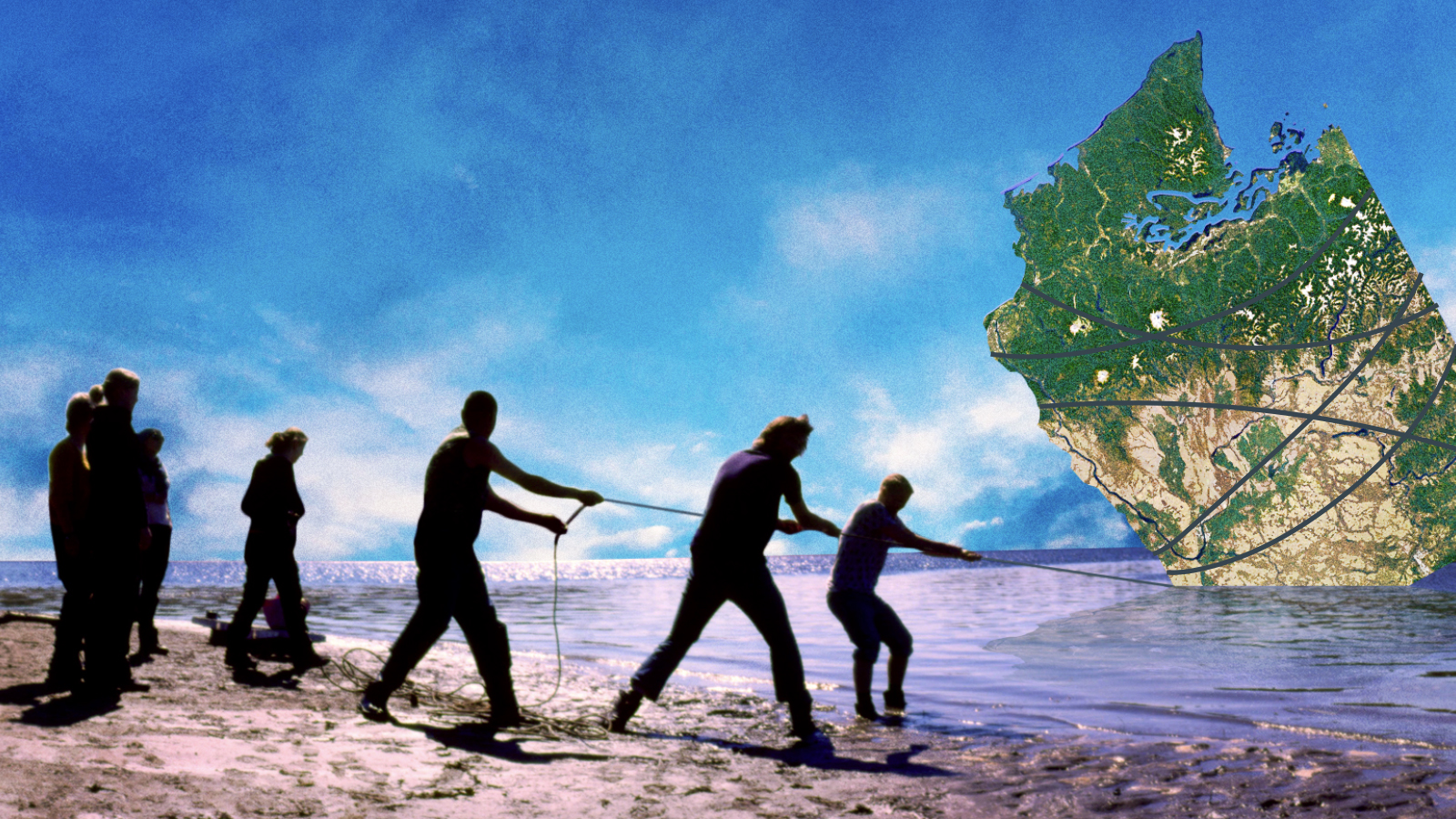Beth Brunton’s magenta umbrella shields her from the weather on an April afternoon in Seattle. Beth Brunton�
“It gets their attention,” she says about her umbrella, as a diverse array of bare-armed people wearing sunglasses pass by on the brick-red campus of Seattle Central College. Brunton stops a young black woman.
“Have you signed to put clean energy on the ballot?” Brunton asks.
The woman stops to listen to the pitch, then shakes her head: No, she can’t sign, because she’s not registered to vote. A lot of people Brunton approaches aren’t — too young, no home address, just a tourist passing through. One man had a felony conviction and hadn’t yet registered to vote again.
Brunton got 40 signatures in the two hours she spent hunting down voters on a street corner at the edge of campus. It’s a sliver of the 260,000 that the initiative, also known as the “Protect Washington Act,” needs in order to appear on the ballot this November. If it passes, Initiative 1631 would become the first fee on carbon in the country — and the first law adopted by a state that looks anything like a carbon tax.
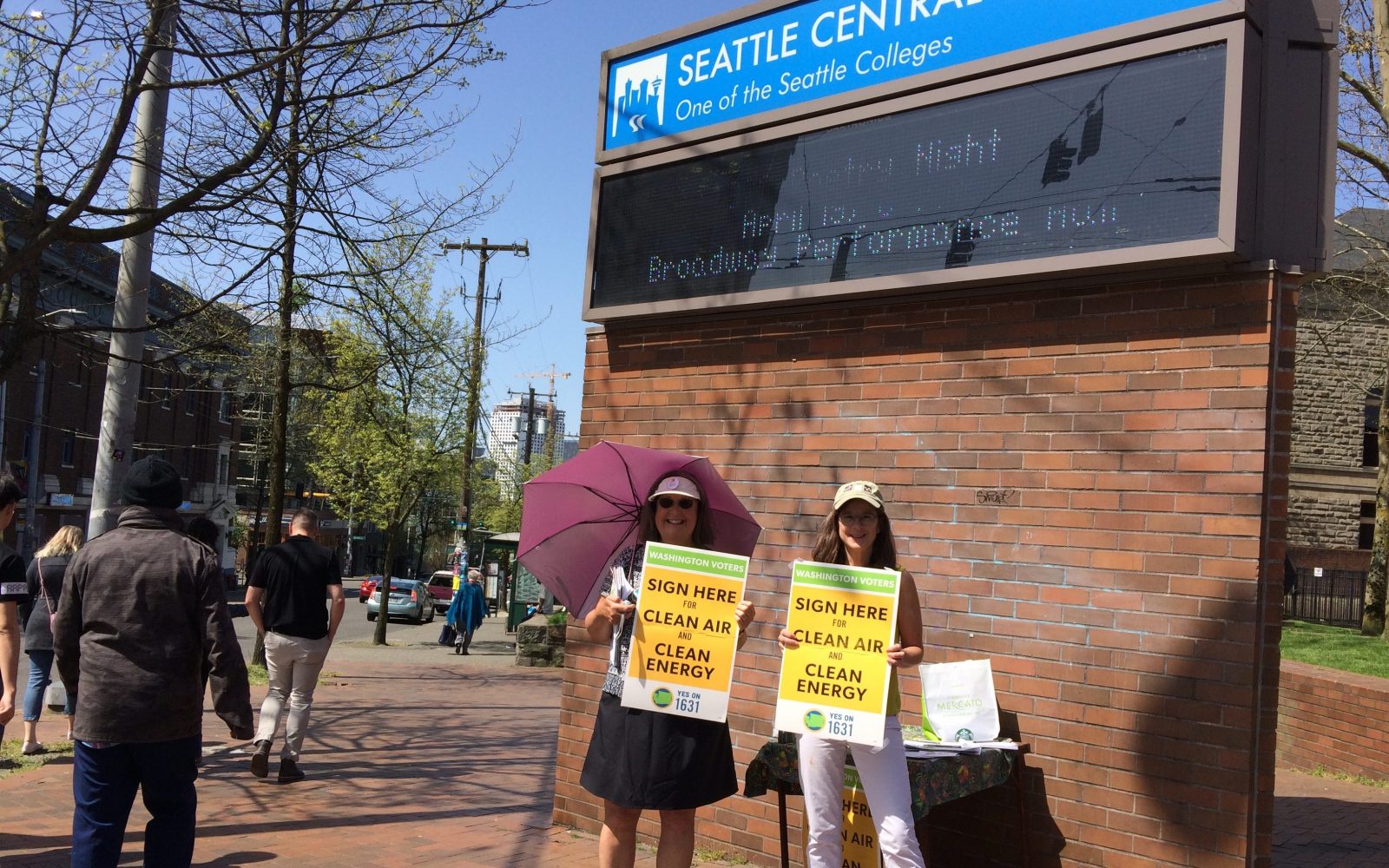
Beth Brunton poses with a friend at Seattle Central College. Kate Yoder / Grist
Just two years ago, Washingtonians rejected a “carbon tax” initiative, which would have initially charged businesses $25 per metric ton of emissions before ramping up over time. The debate over I-732 drove a rift between progressives. While it found some high-profile supporters, from Leonardo DiCaprio to the state’s Audubon Society, it was criticized by activist author Naomi Klein, the Washington Sierra Club chapter, and the Seattle Times editorial board.
This time around, the coalition behind the Protect Washington Act is taking a different tack, rebranding the effort to put a price on carbon and bringing the climate conversation to the streets in hopes of generating broad support. The initiative proposes a “fee on pollution” that would put a $15 charge on each metric ton of carbon dioxide emitted in Washington starting in 2020. That charge would rise by $2 plus inflation every year until the state meets its climate goals, which include cutting its carbon footprint 36 percent below 2005 levels by 2035. The revenue raised would go toward investing in clean energy; protecting the air, water, and forests; and helping vulnerable communities prepare for wildfires and sea-level rise.
The groups behind the proposal are “hands-down the most diverse coalition I’ve seen in 20 years,” says Aiko Schaefer, director of Front and Centered — an alliance of organizations advocating for low-income residents and people of color that played a key role in drafting the new initiative.
Experts agree that putting a price on carbon is one of the best ways for a government to act on climate change. And public opinion polls have found that almost 70 percent of Washington voters — including a solid majority of the state’s Republicans — would support a measure to regulate carbon pollution. But no one has successfully managed to craft a policy that satisfies the whole environmental movement or the electorate.
There are reasons to believe that this time could be different. If I-1631 passes, it could serve as a template for an approach that could one day go national, state by state. Groups in Oregon and in Northeastern states have reached out to the initiative’s backers, inspired by Washington’s approach. And you can bet that they — and others — will be watching this fall.
In the days following the elections in November 2016, as progressives grappled with the idea of President-elect Donald Trump, an opinion research firm interviewed Washington voters to find out what went wrong with I-732. It’s not that the electorate didn’t want action on climate change — 67 percent said they did. But almost 30 percent of respondents said they saw the carbon tax as “too flawed” and wanted to wait for a better measure to come along.
That failed initiative was criticized for its lack of ambition. Opponents argued that it wouldn’t curb emissions, improve Washington’s budget mess, or provide much help to the state’s vulnerable populations. Others complained that groups representing low-income communities and people of color had been left out of the drafting process. Proponents acknowledged all the criticism, but countered that these weren’t good enough reasons for environmentalists to thwart an ambitious effort to tackle climate change.
Earlier this year, State Senator Reuven Carlyle, who represents neighborhoods in Northwest Seattle, proposed a carbon tax that would fund clean energy initiatives and assist low-income residents by offsetting their utility bills. But the bill lost the support of groups like the Quinault Indian Nation on Washington’s Olympic Peninsula. Matthew Randazzo, the Quinault’s policy representative, says the tribe thought that its needs weren’t addressed. In the end, Carlyle’s bill fell short of passing on March 1.
Governor Jay Inslee says he’s more optimistic that his state’s voters will approve the Protect Washington Act than the state legislature will manage to pass a carbon tax. “Frequently, the public transforms faster than politicians recognize,” he tells Grist. “I think that is true on climate change.”
Inslee has endorsed the initiative but says that if it fails, the legislature will be back working on another carbon-pricing proposal next session. “One way or another,” the governor explains, “we’re going to get this job done.”
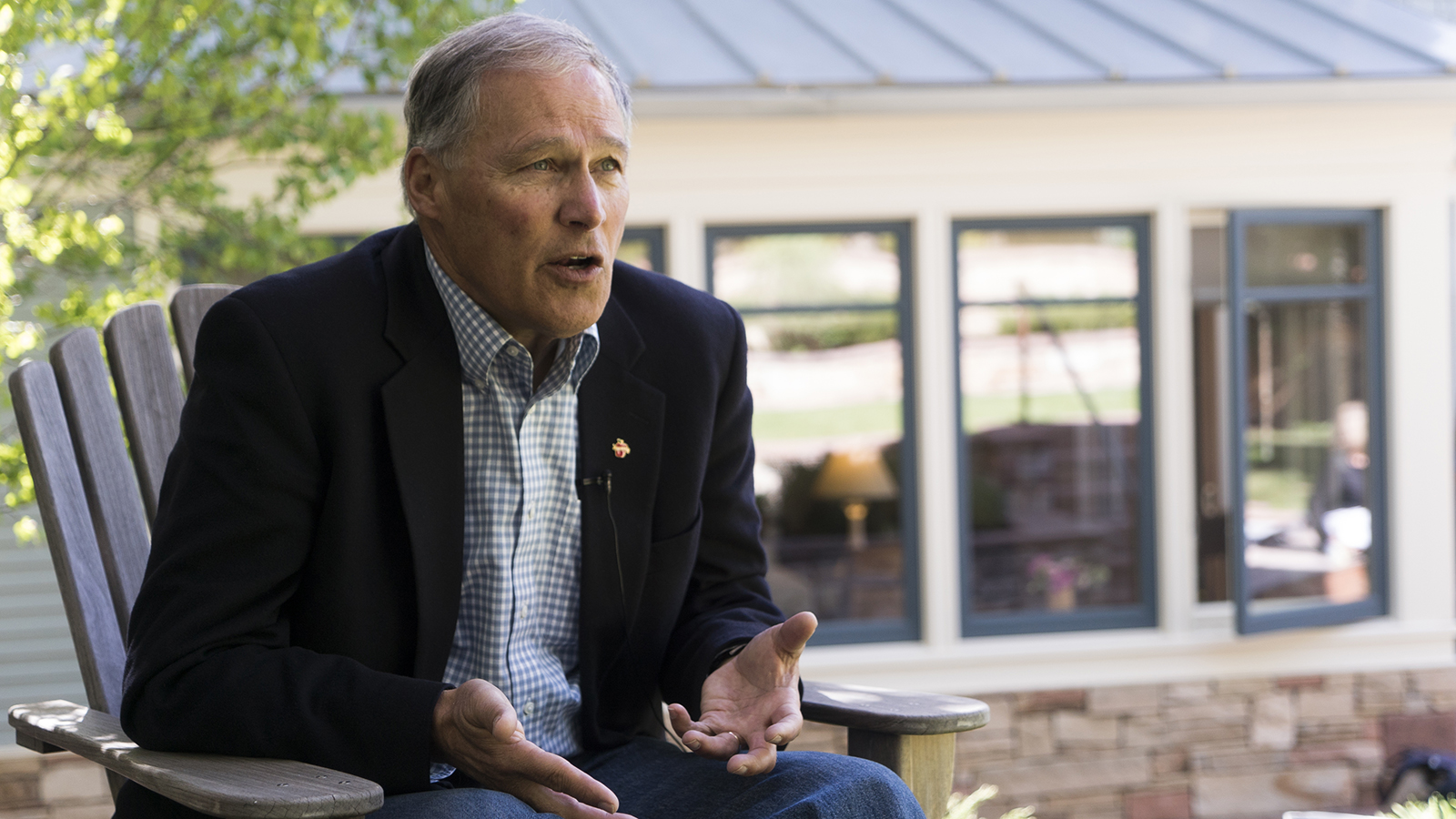
Governor Inslee. Jesse Nichols / Grist
Legislative failures have stymied efforts to curb carbon emissions across the country for more than a decade. An attempt to pass a national cap-and-trade program, the Waxman-Markey bill, passed a Democrat-controlled House in 2009, then failed to come up for a vote in the Democrat-controlled Senate. Its demise ushered in a “bleak time” for environmentalists, says Gregg Small, executive director of the Climate Solutions, a Pacific Northwest-based clean energy nonprofit.
Although California and Northeastern states have since figured out how to get regional cap-and-trade schemes rolling, Washington and Oregon — two reliably progressive states — have struck out. (Earlier this year, Oregon ditched its plans for a cap-and-trade program.) The blame falls not on the usual suspects — Big Oil, Big Coal, Keyser Söze — but on environmentalists themselves. The groups working to protect mountains and rivers, promote climate action, and advance social justice often disagree about how things should be done.
Small says that after some post-Waxman-Markey soul-searching, Washington’s climate groups realized the issue: Their makeup was too white and white-collar to build the sort of support needed to pass ambitious legislation. So they began to reach out to grassroots organizations around the state to form a broader coalition that could wield more political power.
“This went from relatively a small handful of predominantly white-led environmental organizations,” Small says, “to a table of shared power and decision-making between labor and environmental organizations and communities of color.”
The ultimate goal wasn’t just to develop relationships with these communities and get their votes on the ballot. It was to create climate legislation that filled in the gaps of previous bills, benefiting the widest swath of people possible and representing voices that often get ignored. The thinking was that such a measure could be bulletproof against attacks from the left — and as a result, more likely to win over blue voters in Washington.
This new coalition started work on crafting legislation in late 2014. First, it looked south, borrowing lessons from California’s cap-and-trade program, which went into effect more than a decade ago. Although that bill, AB-32, passed with bipartisan support in 2006, grassroots advocates opposed it, arguing that it wouldn’t decrease pollution in low-income areas and communities of color.
A couple years after the program went into effect, that criticism looked prescient. Emissions had risen in some parts of California where air quality was already bad, says Manuel Pastor, director of the Program for Environmental and Regional Equity at the University of Southern California. That put people at even greater risk for asthma and cancer. California has since introduced legislation addressing local pollution problems, thanks largely to a growing number of Latinos from those polluted neighborhoods winning seats in the California State Assembly.
Seeing what happened in California, Washington groups working on the proposal that would become the Protect Washington Act sought to bake justice into their climate-legislation recipe, starting the conversation with communities that suffer the most from carbon emissions. A unique mishmash of businesses, labor unions, faith communities, environmental organizations, public health groups, and communities of color fused in January 2015 into a formal organization committed to developing the then-budding climate policy: the Alliance for Jobs and Clean Energy. Members say they hope to show other states that a grassroots coalition is the way to win.
But before it could become an example for the other 49 states, the Alliance needed to make amends with a group that was key to the success of its climate proposal: the Native American tribes of Washington.
Last summer, the Alliance met with tribal leaders asking them to endorse the carbon fee. According to Fawn Sharp, president of both the Quinault and the Affiliated Tribes of Northwest Indians, the Alliance hadn’t sought meaningful feedback from indigenous communities at that time. Sharp says that’s not surprising, since tribes had not been seriously consulted in any previous carbon pricing proposals in Washington state, either.
After that meeting, Sharp and other tribal leaders announced they were considering putting their own carbon tax on the ballot in 2018. Climate change is an urgent matter for the Quinault Indian Nation, which is frantically drawing up plans to relocate from its ancestral villages because of sea-level rise.
They later scrapped their proposal after reaching an agreement with the Alliance. Six months of discussions with 29 different tribes brought forth what Matthew Randazzo, the policy consultant for the Quinault, calls “the most rigorous and extensive tribal consultation anyone I’ve been working with has ever encountered.” And as a result, I-1631 addresses myriad tribal issues, from generating aid to assist with the coastal relocation of the Quinault to mitigating the wildfire threats faced by tribes in eastern Washington.
“We said, ‘Look, for us to endorse this, tribal nations need to have a role — we need to have a voice, we need to be consulted, ” Sharp tells Grist. “And to their credit, they responded right away.”
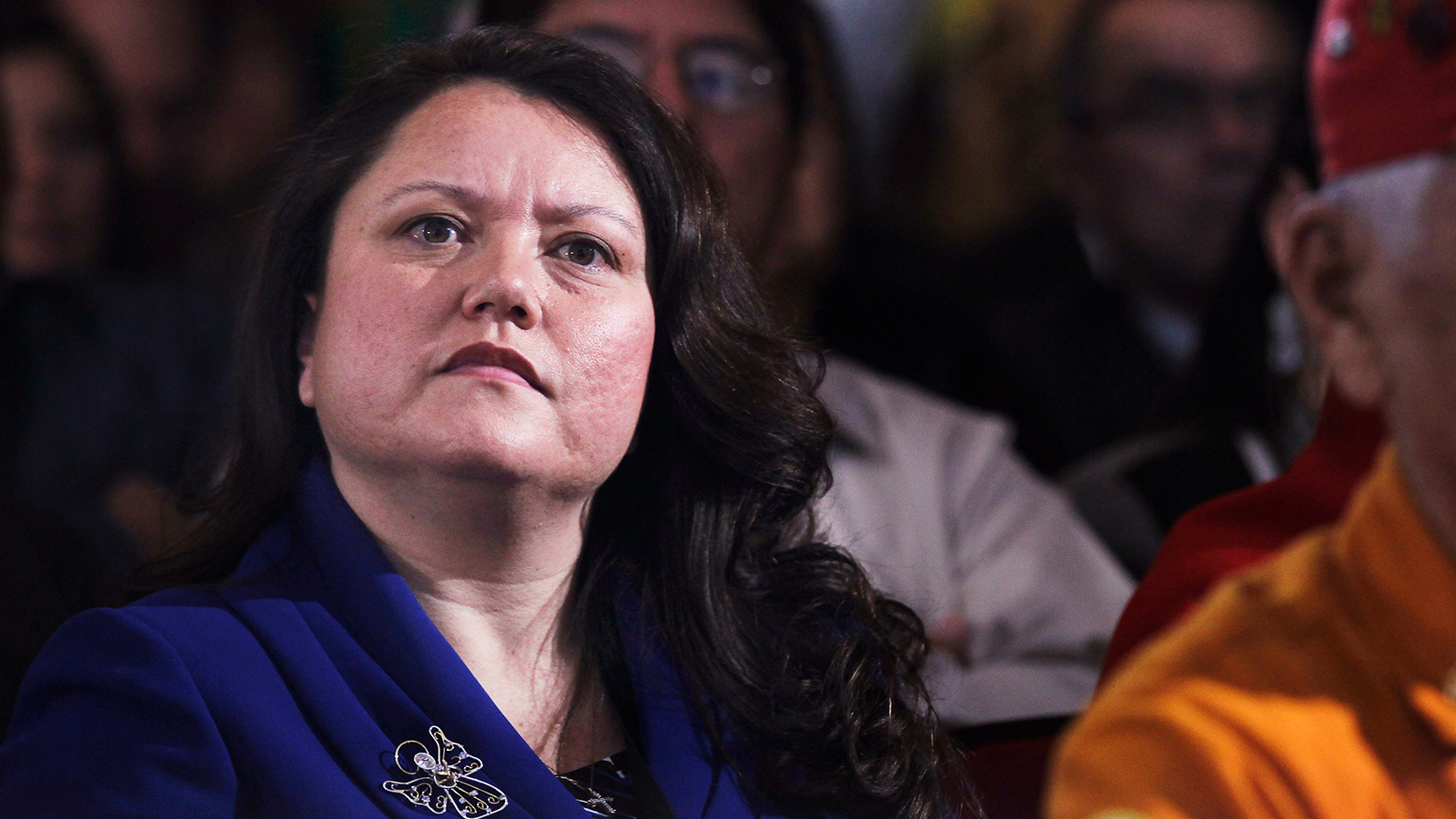
Fawn Sharp. AP Photo / Pablo Martinez Monsivais
Other groups were also wary at first. Getting approached by predominantly white environmental groups “almost felt like being tokenized,” says Edgar Franks of Community to Community, which works with immigrant farmworkers in northwest Washington. So Franks and leaders of other grassroots groups formed their own partnership, Front and Centered, to figure out how to negotiate with the traditional greens.
Last summer, Front and Centered held a series of “listening sessions” where people voiced their concerns about climate and environmental burdens. Across the state, people of color, low-income households, immigrants, and refugees took part. Franks then took the ideas he gathered from this extended community back to the Alliance.
When talking to agricultural laborers about climate legislation, Franks says, representatives from Community to Community eschewed scientific facts and figures in favor of asking about people’s perceptions of the world around them. They posed questions like: Have you noticed it’s been getting hotter? Have you been getting headaches? Do you think higher temperatures have anything to do with you getting sick?
“The science is important,” Franks explains. “But in our community, if you talk about science, it’s a way to not get invited back into the conversation.”
From an environmental standpoint, the main concern among Franks’ constituency is pesticide exposure, which many farmworkers say causes headaches. Although I-1631 doesn’t address pesticides, it’s safe to say that climate change is making their lives more difficult. After all, they toil long hours to meet harvest quotas and don’t get breaks or days off when ambient conditions become dangerous — like when temperatures soar over 100 degrees Fahrenheit or when wildfire smoke hangs heavy in the air.
Another concern is that higher fuel prices could hurt the agriculture industry. Thus, the carbon fee is designed to exempt diesel fuel used solely for agricultural purposes, like transporting produce from a farm.
It also exempts some industries, like aluminum. These so-called “energy-intensive, trade-exposed” industries have prices for their commodities set by international markets. Some worry that if they’re charged extra to operate in Washington, they could pick up shop and pollute elsewhere.
Schaefer from Front and Centered says she hopes Washington can work with these industries to bring down emissions while also keeping them in the state. “We want to hold large corporate polluters responsible for the mess they’re creating,” she says. “But we don’t want to make people poor or have workers lose their jobs in the process.”
As a result, the Protect Washington Act includes a provision to set aside a minimum of $50 million a year to help protect workers “who are affected by the transition away from fossil fuels to a clean energy economy.” That money would go toward protecting incomes and benefit plans for everyone from farm workers to refinery workers, as well as supporting job retraining.
These accommodations for labor, Franks says, are a big reason why he thinks farmworkers are supporting the initiative. That along with the feeling that their concerns were heard for once.
“It’s not just a policy for us,” Franks says. “It’s personal.”
Today, the larger environmental movement is in the bumpy process of shifting from a campaign led mainly by white people to one that prioritizes diversity. This undertaking of building relationships and trust between communities takes a long time, as environmental advocates in Washington have discovered in their nearly decade-long quest to put forward a carbon-pricing measure that disparate groups could support.
While people like Matthew Randazzo and Aiko Schaefer laud the Protect Washington Act, there are some who think it has plenty of flaws. Critics like the duo behind the 2016 carbon-tax proposal, economist Yoram Bauman and environmental activist Joe Ryan, argue that the proposal’s approach is likely to turn off Republicans, independents, and anyone who instinctively votes against taxes.
“What’s fundamentally important about climate action in Washington state, which accounts for about 0.3 percent of global carbon emissions, is increasing the odds of climate action in Washington, D.C.,” the pair wrote in the Seattle Times in April. “That will happen under the Alliance’s unite-the-left approach only if the Democrats can build a national majority considerably stronger than the one currently led by the Republicans. That’s a tall order.”
Small of Climate Solutions says that “uniting the left” is not a fair characterization of the Alliance for Clean Jobs and Energy. While he admits it is “fundamentally an alignment of progressive voices,” the broader coalition behind the initiative includes representatives people from across the political spectrum, including businesses.
“I think it’s a very well balanced proposal,” says Governor Inslee, siding with Small. “It’s moderate in the sense that it responds to the needs of a broad spectrum of people, not one ideology or one ethnic group.”
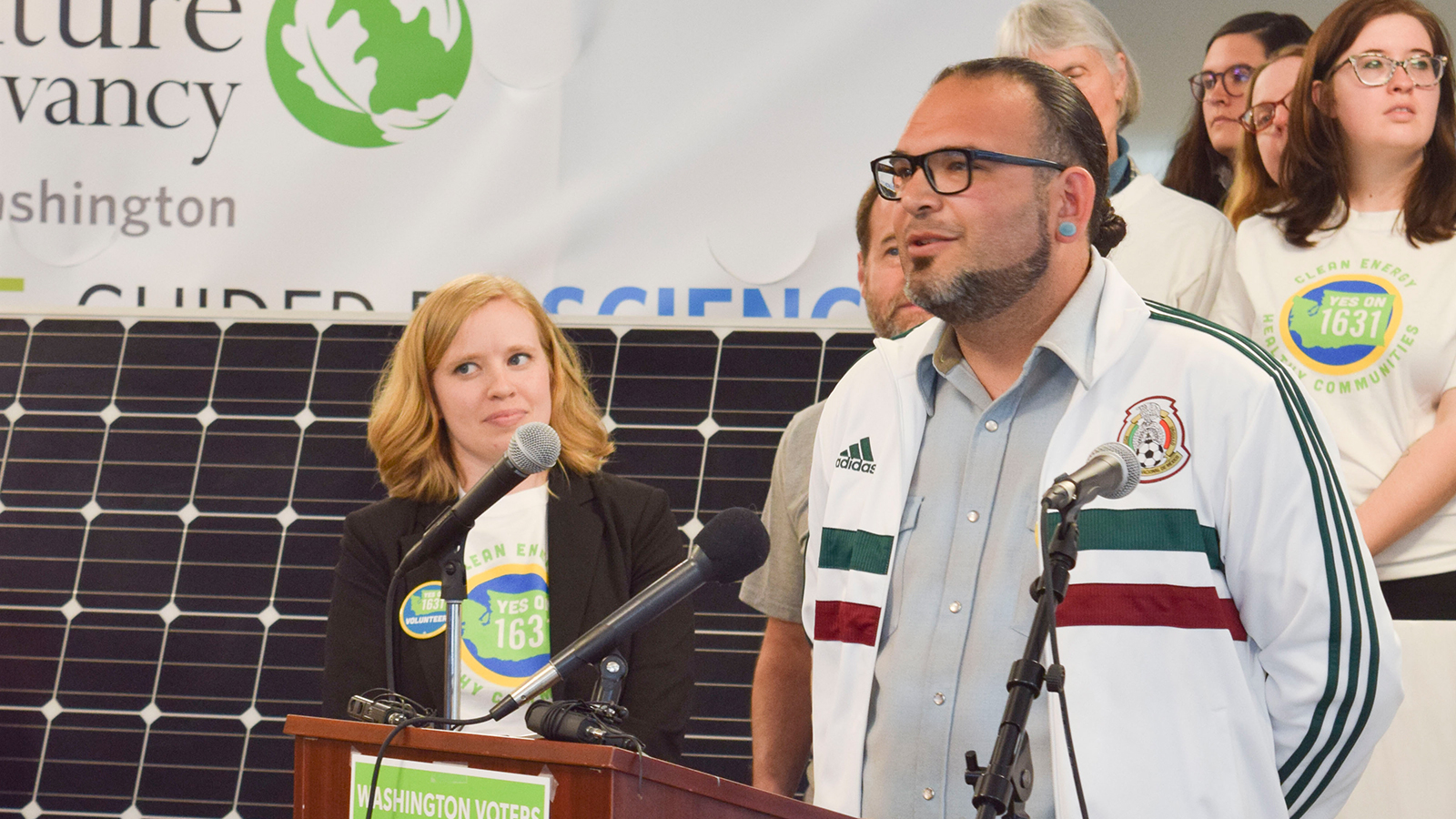
Edgar Franks speaks at a rally for I-1631 in Seattle. Kristi Nakata / Washington Environmental Council
The first words that the Washington electorate read when it voted on the 2016 ballot measure were “Initiative Measure No. 732 concerns taxes.” The new proposal avoids the dreaded t-word. After all, it’s technically a fee — like a highway toll. Whereas revenue from a general tax might go toward whatever the government decides to spend it on, a fee ensures that funds go straight to a designated purpose. In the case of I-1631, that means 70 percent goes to investing in clean energy and clean air, 25 percent goes to maintaining water sources and forests, and 5 percent goes to helping communities throughout the state prepare and adapt to challenges caused by climate change.
Moneys in the account must be used for programs, activities, or projects to prepare communities for challenges caused by climate change and to ensure that the impacts of climate change are not disproportionately borne by certain populations.
But tweaking the language from “tax” to “fee” isn’t a magic trick that will finally make a climate bill appear in Washington state, says Anthony Leiserowitz, director of the Yale Program on Climate Change Communication. He warns that the Alliance can’t run away from the t-word.
“As soon as the opponents start organizing,” Leiserowitz says, “they’re going to call it a tax.”
What’s more, detractors are likely to point out that while a carbon price will be charged to polluters — an idea Americans broadly support — Washington residents are likely to pay part of the costs when they fill up their cars with gas or pay their utility bills, Leiserowitz says.
For now, I-1631 just needs to win over the people of Washington state, which has looked like a progressive stronghold in recent years. The state legalized same-sex marriage ahead of the curve in 2012 and became the first to legalize recreational marijuana. Two years later, Seattle was among the first cities to adopt a $15 minimum wage.
“This is a place of innovation, a place where broad and progressive ideas spread across the country,” Schaefer says. “And we believe this initiative will be the same.”
The Protect Washington Act is on track to exceed its goal of 260,000 signatures before the end of June, according to Nick Abraham of Washington Conservation Voters. That’s despite just clearing the halfway mark by the end of May.
Even if the Protect Washington Act fails, the groups who feel like people are finally involving them in the democratic process are going to hold down that space and fight for it. In that respect, Franks of Community to Community says many of state’s residents, like the farm workers he represents, have already won.
“Being treated with respect and dignity and being heard, that goes further than any policy.”
